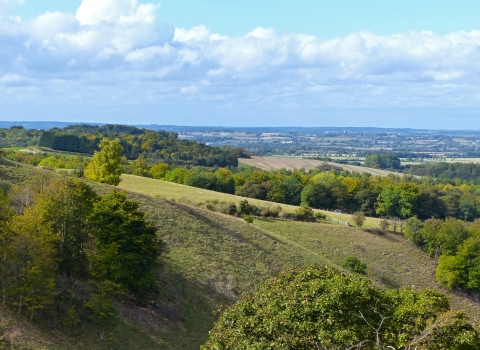The Wildlife Trust manages a number of nature reserves in the North Chilterns Chalk Living Landscape including rare chalk downland sites home to many threatened species.
Conservation Grazing
The unpredictable weather has made managing our grazing on the chalk sites problematic – there seems to be no happy medium between no grass and too much! We experimented last winter taking our cows to the Great Fen, which meant that they had plenty to eat – but it also took more staff time, so we have found somewhere closer to home for the cattle to winter this year. They will be back in the spring!
Find out more about conservation grazing and how it is crucial for maintaining our grasslands.
Work Parties
We have been collaborating with the National Trust at our Totternhoe, sharing staff and volunteer resources to hold large work parties on both National Trust and Wildlife Trust land which has proved to be an extremely successful venture.
Totternhoe nature reserve is made up of spoil heaps left from long-ago quarrying that have developed into impressive flower-rich chalk grasslands. Small-scale quarrying continues today to provide stone for historic buildings.
TV Fame!
Those regular viewers of Country File will have seen the excellent feature on our Totternhoe reserve, which highlighted our work particularly in respect to the Duke of Burgundy butterflies (although sadly Richard Knock’s star turn got cut).
Find out more about this project.
Funding
We are very glad to have received funding for some of our work in the North Chilterns Chalk Living Landscape – our priority living landscape for Bedfordshire.
We have secured funding through Biffa for Totternhoe nature reserve, which will primarily go towards fencing and scrub work.
We have also received funding from the Central Bedfordshire Council for Pegsdon Hills and Hoo Bit nature reserve, which has been used to buy a fantastic tractor-mounted post knocker, which will enable us to carry out more fencing ourselves, rather than relying on contractors. Funding will also be paying for updated interpretation at Pegsdon.
We also have money for work at Blow’s Downs, which will fund further fencing and habitat management.
You will note that a significant proportion of our recent funding is being spent on fencing because much of it was put in at the same time, several years ago; the posts are now starting to rot and are needing replacement. Fencing is an important part of reserves management as it allows us to graze areas of the reserves with livestock, which keeps scrub under control and allows the more sensitive plants and flowers to thrive; this in turn supports a wider range of invertebrates and birds. Fencing also helps to ensure that visitor access to our reserves is clearly marked, offering protection to the more sensitive areas.
Council funding has come through Section 106, which is money provided through agreements made between developers and local councils to mitigate the impacts caused by some new developments. The agreements fund schemes to make improvements to the surrounding area, thereby ensuring that where possible the development will make a positive contribution to the local area and community.


